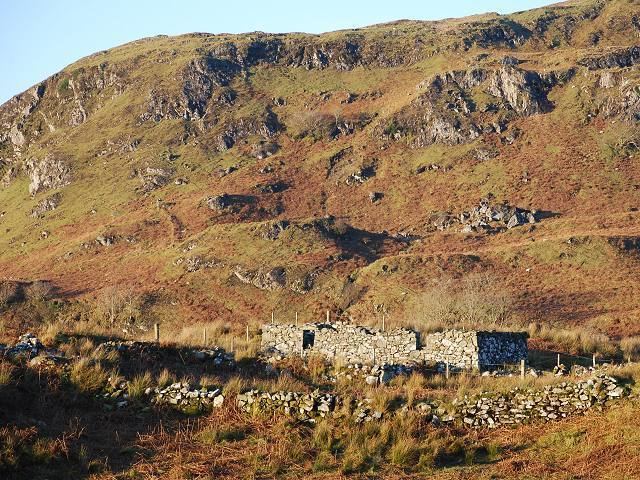 | ||
A shieling (Scottish Gaelic: àirigh), also spelt sheiling, shealing and sheeling, is a hut, or collection of huts, once common in a wild or lonely place in the hills and mountains of Scotland and northern England. The word also refers to a mountain pasture used for the grazing of cattle in summer.
Contents
Etymology
The term shieling is mainly Scottish, originally denoting a summer dwelling on a seasonal pasture high in the hills, particularly for shepherds and later coming to mean a more substantial and permanent small farm building in stone. The first recorded use of the term is from 1568. The term is from shiel, from the Northern dialect Middle English forms schele or shale, probably akin to Old Frisian skul meaning 'hiding place' and to Old Norse Skjol meaning 'shelter' and Skali meaning 'hut'.
Seasonal dwelling
Farmers and their families lived in shielings during the summer to have their livestock graze common land. Shielings were therefore associated with the transhumance system of agriculture. The mountain huts generally fell out of use by the end of the 17th century, although in remote areas this system continued into the 18th.
Ruins of shielings are abundant in high or marginal land in Scotland and Northern England, along with place-names containing "shield" or their Gaelic equivalents, with names such as "Shiels Brae" near Bewcastle. Some were constructed of turf and tend to gradually erode and disappear but traces of stone-built structures persist. Some shielings are mediaeval in origin and were occasionally occupied permanently after abandonment of the transhumance system. The construction of associated structures such as stack-stands and enclosures indicate that in these cases they became farmsteads, some of which evolved into modern farms.
In his 1899 book The Lost Pibroch, Neil Munro refers to the shieling as something temporary: "the women, posting blankets for the coming shieling..."; "It was about the time Antrim... came scouring through our glens..., with not a shieling from end to end, except on the slopes of Shira Glen..."; "...for never a shieling passed but the brosey folks came pouring down Glenstrae, scythe, sword, and spear, and went back with the cattle before them..."
Memories in folksong and poetry
The well-known folksong Mairi's Wedding contains the phrase "past the shieling, through the town" which helps protect this word from obscurity. A Gaelic song (covered on Uam by Julie Fowlis) is Bothan Àirigh am Bràigh Raithneach ("A shieling on the Braes of Rannoch"), while the 'weaver poet' Robert Tannahill's song to "Gilly Callum" begins "I'll hie me to the shieling hill, And bide amang the braes, Callum..."
The temporary nature of the shieling, and its location high in the Scottish hills is alluded to in the musicologist William Sharp's Shieling Song of 1896, which he published under the pseudonym "Fiona MacLeod": "I go where the sheep go, with the sheep are my feet... O lover, who loves me, Art thou half so fleet? Where the sheep climb, the kye go, There shall we meet!" (Kye means "cattle".)
The shieling could be on a Scottish island, as in Marjory Kennedy-Fraser's delicate tune "An island shieling", recorded on "Songs of the Hebrides" by Florence McBride. Edward Thomas's poem "The Shieling" evokes the loneliness of a quiet old highland building that "stands alone/Up in a land of stone...A land of rocks and trees..."
Surviving shielings in Scotland and elsewhere
Among the many surviving buildings named shieling is Shieling Cottage, Rait, Perth and Kinross, an 18th-century cottage of clay-bonded rubble, originally roofed in thatch, now in slate.
The 'Lone Shieling', built in 1942 in Canada's Cape Breton Highlands National Park, is modelled on a Scottish 'bothran' or shepherds' hut of the type that was used during the summer when it was possible to move the sheep up on to the hills to graze. It has the same design as the Lone Sheiling on the Scottish isle of Skye, romanticised in the lines "From the lone shieling of the misty island/Mountains divide us and the waste of seas – Yet still the blood is strong, the heart is Highland, And we in dreams behold the Hebrides."
Derek Cooper, in his 1983 book on Skye, suggests that the isolation of shielings gave opportunity for "sexual experiment[ation]", and in evidence identifies a moor named "Araidh na suiridh", the bothy of lovemaking. The song Bothan Àirigh am Bràigh Raithneach confirms this with the verse "And we'll rear them in a shieling on the Braes of Rannoch, in the brush-wood enclosed hut of dalliance."
The buildings on the moors were repaired each summer when the people arrived with their cattle; they made butter and cheese, and "gruthim", salted buttered curds.
